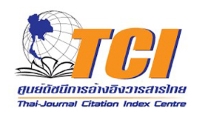JOURNAL DETAIL
Fatigue Analysis Model for Applying Bioglass–Hydroxyapatite Biocomposite LCP Bone Fixation Plates to Fix Humeral Shaft Fractures
Paper Type |
Contributed Paper |
Title |
Fatigue Analysis Model for Applying Bioglass–Hydroxyapatite Biocomposite LCP Bone Fixation Plates to Fix Humeral Shaft Fractures |
Author |
Siwasit Pitjamit and Wasawat Nakkiew* |
Email |
wasawat@eng.cmu.ac.th |
|
Abstract: Generally, there are several methods to treat patients who suffer from humerus fractures caused by accidents, such as internal fixation, external fixation, and a nail system. Bone fixation with
locking compression plates (LCPs), one of the most famous internal fixation methods, is used to treat
humerus shaft fractures. However, cracks and fractures can occur on the plate before the humerus
fracture is completely rejoined, in which case the patient needs another surgery. There were two main
purposes for this research: one was to find suitable forming conditions of LCPs synthesized from
biomaterials, and the second was to obtain a suitable fixation method using LCPs. For the former,
hydroxyapatite powder from bovine bone was synthesized, and bioactive glass powder from mollusk
shell was prepared with chemical reactions. The materials were blended and ground with a high-speed
ball milling machine to reduce and thoroughly mix them before forming the proposed materials. A
hydraulic pressing machine was then used to compress the formed composites. The Taguchi experimental
design was used to evaluate essential factors of forming conditions, such as sintering temperature,
compacting pressure, mixing ratio, and holding time for pressing. The results demonstrate that a ratio
of bioactive glass to hydroxyapatite of 30:70 wt%, 30 MPa compacting pressure, and 5000 °C sintering
temperature provided the highest compressive and bending strength of 249.46 MPa and 29.16 MPa,
respectively. The bulk density of the specimen was 3.16 g/cm3, and the biomaterials, tested by lactate
dehydrogenase (LDH) analysis, can be used on the human body since it they are biodegradable in
3980 days, which is long enough for bone healing. For the second purpose, the S-N curve of the
specimen was obtained via experiment and then used to create a finite element model of bone fixation
using LCPs. Important factors of fracture gap, number of screws on the plate, and axial compression
force were considered in finding suitable bone fixation conditions in the finite element model. Based
on the response surface method (RSM), the results of statistically significant factors showed that
the axial compression force was 182 N by using six screws, resulting in the greatest fatigue life. The
results of this paper could assist orthopedic surgeons in understanding the biomechanical efficiency of
bone fixation using LCPs. In addition, surgeons can select a fixation technique based on the patient’s
condition using the numerical results from this study. |
|
Start & End Page |
231 - 251 |
Received Date |
2020-04-01 |
Revised Date |
|
Accepted Date |
2020-06-15 |
Full Text |
Download |
Keyword |
locking compression plate, hydroxyapatite, bioglass, fatigue life, finite element analysis, bone fixation, bioceramic |
Volume |
Vol.48 No.1 (January 2021) |
DOI |
|
Citation |
Pitjamit S. and Nakkiew* W., Fatigue Analysis Model for Applying Bioglass–Hydroxyapatite Biocomposite LCP Bone Fixation Plates to Fix Humeral Shaft Fractures, Chiang Mai Journal of Science, 2021; 48(1): 231-251. |
| View:905 Download:505 | |
RELATED ARTICLE
Increased Antibacterial Activity of Zinc-Silver Doped Hydroxyapatite Synthesized via Ultrasonic in Combination with Sol-Gel Technique using Glutinous Rice as a Template
Article ID: e2024044
Author:Piaw Phatai, Sirilak Kamonwannasit, Sakuntala Siri-udom, Cybelle Morales Futalan, Pongtanawat Khemthong, Saran Youngjan, Teera Butburee, Khongvit Prasitnok and Orrasa Prasitnok
Vol.51 No.3 (May 2024) View: 903 Download:542
Article ID: e2024044
Author:Piaw Phatai, Sirilak Kamonwannasit, Sakuntala Siri-udom, Cybelle Morales Futalan, Pongtanawat Khemthong, Saran Youngjan, Teera Butburee, Khongvit Prasitnok and Orrasa Prasitnok
Vol.51 No.3 (May 2024) View: 903 Download:542
Application of Hydroxyapatite Nanoparticles as Fertilizer Improved Yield Quality of Rice (Oryza sativa L.)
Article ID: e2023053
Author:Sirinapa Pongpeera and Duangkamol Maensiri
Vol.50 No.5 (September 2023) View: 791 Download:795
Article ID: e2023053
Author:Sirinapa Pongpeera and Duangkamol Maensiri
Vol.50 No.5 (September 2023) View: 791 Download:795
High Cycle Fatigue Life of Ti-6Al-4V Titanium Alloy Processed by Electron Beam Welding
page: 473 - 486
Author:Jiun-Ren Hwang, Chou-Dian Huang, Wei-Han Lin, Jiunn-Yuan Huang and Chin-Ping Fung
Vol.49 No.2 (March 2022) View: 1,623 Download:569
page: 473 - 486
Author:Jiun-Ren Hwang, Chou-Dian Huang, Wei-Han Lin, Jiunn-Yuan Huang and Chin-Ping Fung
Vol.49 No.2 (March 2022) View: 1,623 Download:569
Development of Polycaprolactone Infiltrated Anti-Tuberculosis Drug-Loaded 3D-Printed Hydroxyapatite for Localized and Sustained Drug Release in Bone and Joint Tuberculosis Treatment
page: 105 - 121
Author:Faungchat Thammarakcharoen, Autcharaporn Srion, Watchara Chokevivat, Ruedee Hemstapat, Noppawan Phumala Morales and Jintamai Suwanprateeb
Vol.49 No.1 (Special Issue I : Jan 2022) View: 1,483 Download:462
page: 105 - 121
Author:Faungchat Thammarakcharoen, Autcharaporn Srion, Watchara Chokevivat, Ruedee Hemstapat, Noppawan Phumala Morales and Jintamai Suwanprateeb
Vol.49 No.1 (Special Issue I : Jan 2022) View: 1,483 Download:462
Low Temperature Fabrication of Brushite by PowderBased Three Dimensional Printing Coupled with Phase
Transformation Process
page: 738 - 751
Author:Autcharaporn Srion, Phee Palanuruksa, Faungchat Thammarakcharoen and Jintamai Suwanprateeb*
Vol.47 No.4 (Special Issue II : July 2020) View: 984 Download:500
page: 738 - 751
Author:Autcharaporn Srion, Phee Palanuruksa, Faungchat Thammarakcharoen and Jintamai Suwanprateeb*
Vol.47 No.4 (Special Issue II : July 2020) View: 984 Download:500
BMP-2 Incorporation into 3D Printed Porous Hydroxyapatite by Rapid Biomimetic Co-Precipitation Technique Using Accelerated Calcium Phosphate Solution
page: 723 - 737
Author:Faungchat Thammarakcharoen and Jintamai Suwanprateeb*
Vol.47 No.4 (Special Issue II : July 2020) View: 996 Download:501
page: 723 - 737
Author:Faungchat Thammarakcharoen and Jintamai Suwanprateeb*
Vol.47 No.4 (Special Issue II : July 2020) View: 996 Download:501
Effect of Composition and Sintering Temperature on the Structure and Properties of Porous Bioactive
Glass Scaffolds
page: 568 - 578
Author:Kerim Emre Öksüz*
Vol.46 No.3 (May 2019) View: 856 Download:276
page: 568 - 578
Author:Kerim Emre Öksüz*
Vol.46 No.3 (May 2019) View: 856 Download:276
Physicochemical Properties of Magnesium-doped Hydroxyapatite Nanoparticles Prepared by Incipient Wetness Impregnation Method
page: 1091 - 1099
Author:Jutharatana Klinkaewnarong, Sirilak Kamonwannasit, Piaw Phatai*
Vol.44 No.3 (July 2017) View: 956 Download:324
page: 1091 - 1099
Author:Jutharatana Klinkaewnarong, Sirilak Kamonwannasit, Piaw Phatai*
Vol.44 No.3 (July 2017) View: 956 Download:324
Bioactivity, Cytotoxicity and Antibacterial Evaluation of Undoped, Zn-doped, Sr-doped, and
Zn/Sr-codoped Hydroxyapatites Synthesized by a Sol-gel Method
page: 630 - 639
Author:Likit Temprom [a], Suphasinee L. Seet [a,b,c], Patcharaporn Tippayawat [d], Pimsiree Suwanna* [a,b,
Vol.44 No.2 (April 2017) View: 996 Download:260
page: 630 - 639
Author:Likit Temprom [a], Suphasinee L. Seet [a,b,c], Patcharaporn Tippayawat [d], Pimsiree Suwanna* [a,b,
Vol.44 No.2 (April 2017) View: 996 Download:260
Preparation of Nano-hydroxyapatite Particles by Ultrasonic Method at 25 kHz Using Natural Rubber Latex as a Templating Agent
page: 320 - 328
Author:Songkot Utara [a,b]*, Jutharatana Klinkaewnarong [a,c]
Vol.43 No.2 (SPECIAL ISSUE 1) View: 908 Download:284
page: 320 - 328
Author:Songkot Utara [a,b]*, Jutharatana Klinkaewnarong [a,c]
Vol.43 No.2 (SPECIAL ISSUE 1) View: 908 Download:284
Enhancing coating property and storage stability of non-alkoxide sol-gel derived hydroxyapatite coating by incorporating gel retarding agents.
page: 1341 - 1351
Author:Jintamai Suwanprateeb*, Waraporn Suvannapruk, Faungchat Thammarakcharoen and Watchara Chokevivat
Vol.41 No.5/2 (OCTOBER 2014) View: 840 Download:298
page: 1341 - 1351
Author:Jintamai Suwanprateeb*, Waraporn Suvannapruk, Faungchat Thammarakcharoen and Watchara Chokevivat
Vol.41 No.5/2 (OCTOBER 2014) View: 840 Download:298
Preparation and Characterization of HAP-Glass
Porous Composites
page: 495 - 500
Author:Charussri Lorprayoon* and Shigeki Morimoto
Vol.32 No.3 (SEPTEMBER 2005) View: 833 Download:218
page: 495 - 500
Author:Charussri Lorprayoon* and Shigeki Morimoto
Vol.32 No.3 (SEPTEMBER 2005) View: 833 Download:218
Nanocrystalline Hydroxyapatite Powders by a Polymerized Complex Method
page: 243 - 251
Author:Jutharatana Klinkaewnarong, and Santi Maensiri
Vol.37 No.2 (MAY 2010) View: 852 Download:265
page: 243 - 251
Author:Jutharatana Klinkaewnarong, and Santi Maensiri
Vol.37 No.2 (MAY 2010) View: 852 Download:265
Copyrights © Since 2021 All Rights Reserved by Chiang Mai Journal of Science










